Key takeaways:
- Rewriting is essential for poetry, allowing deeper exploration of the poet’s intentions and emotional honesty.
- Engaging with others and seeking feedback can provide new perspectives that enhance the poem’s impact.
- Techniques like imagery, sound exploration, and structural experimentation can significantly improve poetic language.
- Submitting rewritten poems requires careful adherence to guidelines, considering the evolution of the work, and taking time away for clarity before submission.

Understanding poetry rewriting process
The poetry rewriting process is often where the true magic happens. I remember the first time I reworked a poem that felt flat on the page; it was as if I was peeling back layers to uncover the core emotion. Don’t you find that each reading unveils something new and maybe even unexpected?
When I sit down to rewrite, I often ask myself: What does this poem truly want to say? This question guides me through the revisions, helping me drop unnecessary lines while honing in on the essence. Sometimes, the hardest parts to cut are the lines I love the most, yet I’ve learned that sacrifice often paves the way for clarity.
Revisiting a poem can feel like having a conversation with an old friend; each draft reveals more of our shared history. I’ve experienced moments where a simple shift in word choice transforms the entire tone, making it resonate on a deeper level. Isn’t it fascinating how a poem evolves, reflecting not just our thoughts, but also our growth as writers?
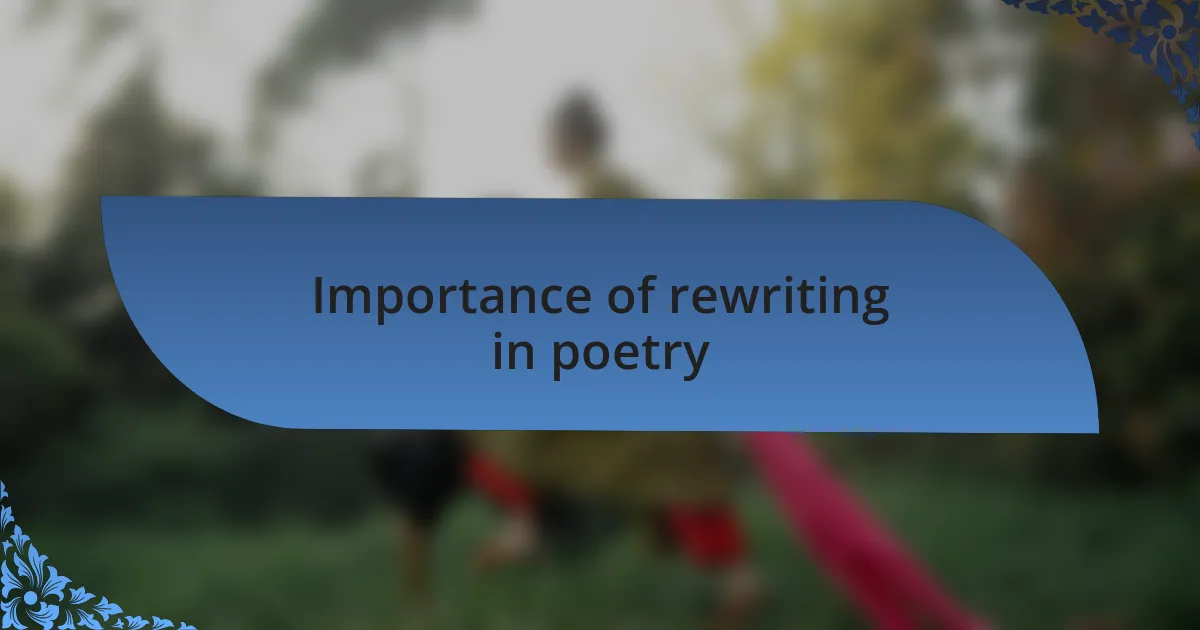
Importance of rewriting in poetry
Rewriting serves as a crucial step in poetry, allowing us to dig deeper into our intentions. I often find that a poem’s first draft resembles a rough sketch, bursting with potential but lacking refined details. Have you ever revisited a piece and realized how much more you could convey with just a few carefully chosen words? That’s the beauty of rewriting— it’s where the raw emotion can transition into something impactful and polished.
Through rewriting, I’ve encountered moments that have reshaped my understanding of the poem. One time, I struggled with a stanza that just didn’t feel right. After multiple rewrites, I discovered that altering just one word at the end changed the reader’s perception entirely. It’s these subtle adjustments that breathe new life into our work, showing me how critical it is to stay open to change throughout the writing process.
The act of revisiting a poem also teaches me resilience. Each round of edits feels like stepping into a new layer of vulnerability. I remember feeling attached to certain images only to realize, through revising, that they diluted the piece’s impact. Questioning those attachments can lead to greater emotional honesty, which ultimately strengthens the poem’s connection with the reader. Isn’t it rewarding to see how embracing this into-the-depths of revision cultivates not just better poetry, but a deeper understanding of ourselves as poets?
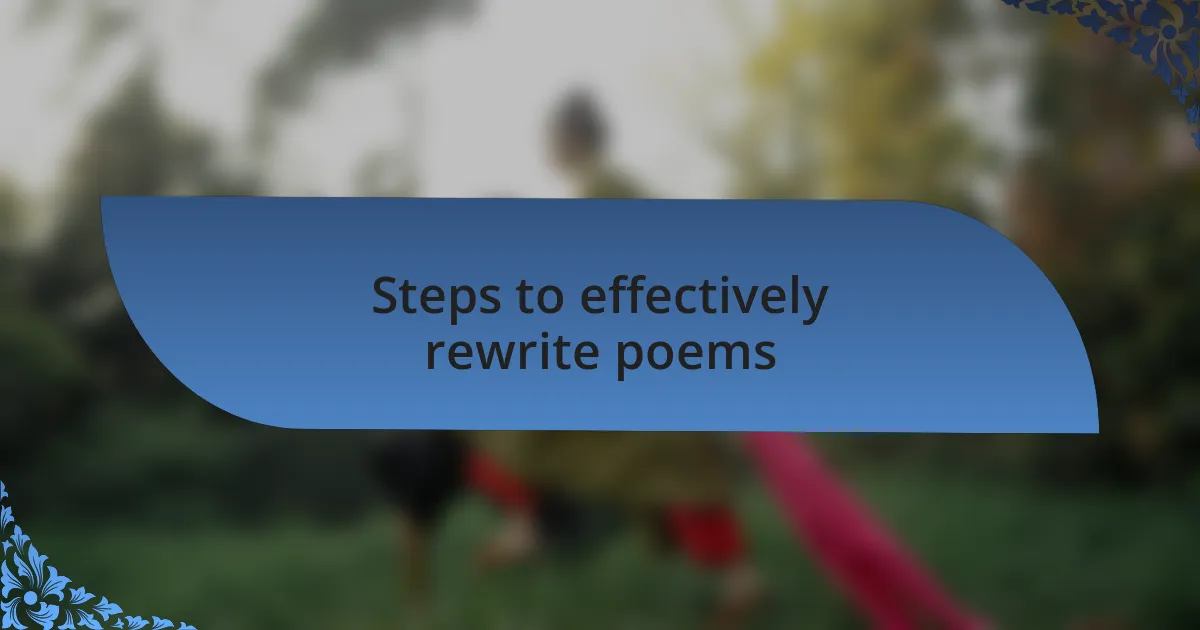
Steps to effectively rewrite poems
To effectively rewrite a poem, I first step back and take a fresh look at my work. I often print out the draft or read it aloud, allowing the words to resonate differently. Have you noticed how hearing your own voice can reveal awkward phrases that your eyes might miss? It’s in that moment of auditory reflection that I pinpoint areas needing clarity or rhythm adjustments.
Next, I focus on one stanza or even a line at a time. I remember a particularly sentimental poem where I was attached to an image that felt meaningful, yet upon isolation, I realized it added confusion rather than clarity. By removing it and experimenting with alternatives, I uncovered a new layer of emotion that felt more authentic. How often do we cling to what we love, only to find that letting go leads to greater artistic freedom?
Finally, I involve others in the process. Sharing drafts with trusted fellow poets has opened my eyes to perspectives I didn’t consider. One time, a friend suggested a different metaphor that transformed my view of the piece altogether. Engaging with others encourages me not only to refine my craft but also to connect on a deeper level with readers. Isn’t it fascinating how collaboration can illuminate paths we hadn’t even thought to explore?
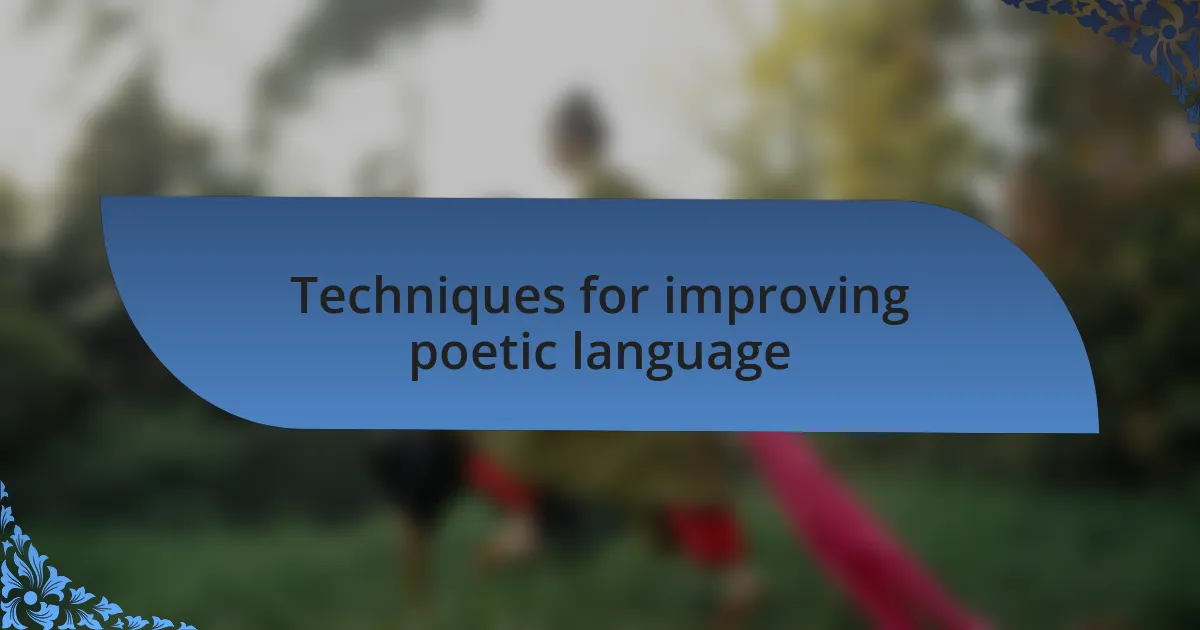
Techniques for improving poetic language
When it comes to enhancing poetic language, I often dive into the world of imagery. I recall a time when I was grappling with a line that felt flat and uninspiring. After countless revisions, I decided to swap out a generic description for something more vibrant. Suddenly, my words transformed into a vivid painting in the reader’s mind, evoking feelings I hadn’t even anticipated. Isn’t it incredible how a single image can carry the weight of emotion?
Another technique I employ is the exploration of sound. The music of poetry holds a special place in my heart. When I was working on a piece about longing, I played with alliteration and assonance, allowing the rhythm of the words to sing. That particular attention to sound not only made the poem more engaging but also reflected the emotional undercurrents I wanted to convey. Have you ever noticed how certain phrases resonate like a melody long after you’ve read them?
Moreover, I’ve found that experimenting with form can breathe new life into my poetry. One of my favorite poems took on a whole new dimension when I altered its structure from a rigid stanza format to a flowing free verse. This shift allowed my thoughts to unfold naturally, almost like a conversation with the reader. It made me realize how shape can influence perception. Have you ever restructured your work to discover hidden meanings waiting to emerge?
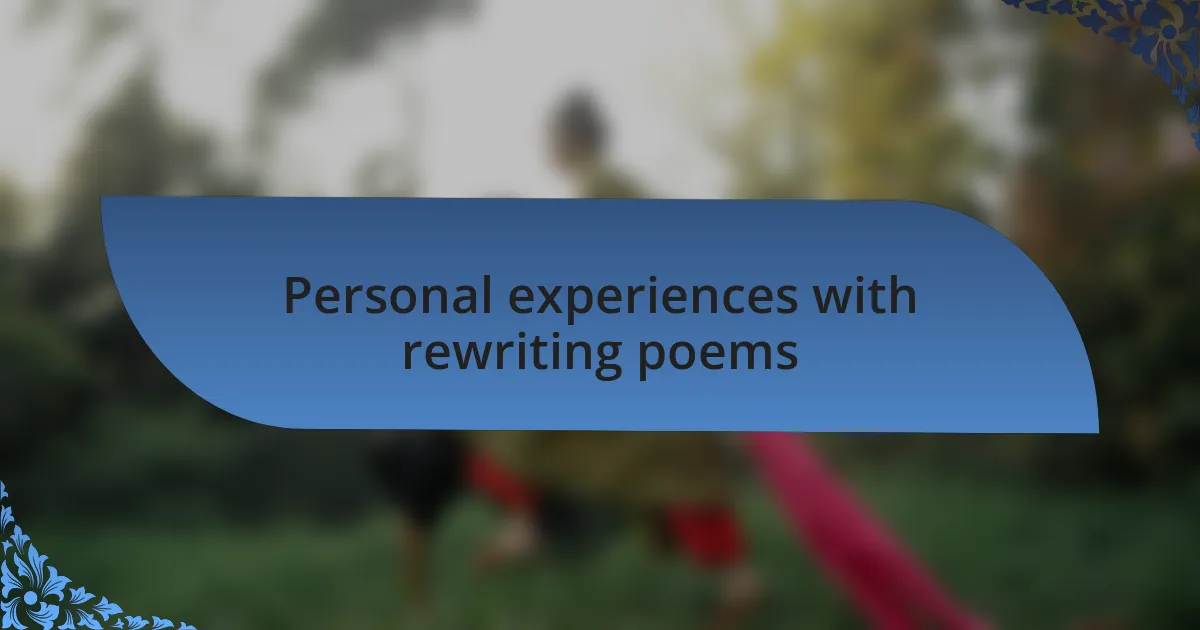
Personal experiences with rewriting poems
I remember a particular poem that started as a simple expression of my feelings but ended up being a cathartic journey. At first, each stanza felt disconnected, but after revisiting it several times, I realized that tightening the focus around a central image brought clarity and depth. It was as if I was peeling back layers of my own emotions, revealing truths I hadn’t acknowledged. Have you ever felt that moment when a rewrite not only changes the poem but also transforms your understanding of yourself?
There was another instance where I sought feedback from a fellow poet, who suggested I explore a different perspective in my lines. This advice was invaluable. When I rewrote the poem through a new lens, it blossomed into a richer narrative. The fresh viewpoint infused my work with unexpected nuances, making it resonate on a deeper level. Isn’t it fascinating how collaboration can guide us to uncharted territories in our writing?
On yet another occasion, I found myself pouring over a poem that touched on loss. The emotional weight made me hesitant to change anything, yet rewriting became a form of healing. I took a risk and wrote multiple drafts, each time allowing different emotions to surface. The final version became more than just a tribute; it was a reflection of my journey through grief. Have you ever experienced the cathartic power of rewriting to navigate your own emotions?
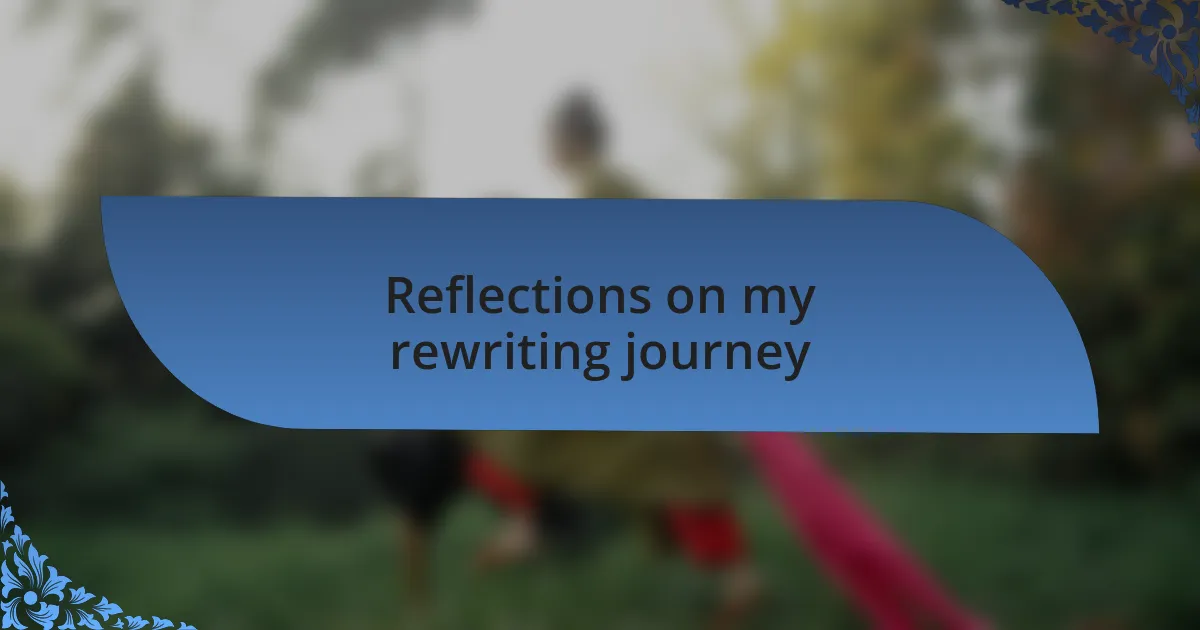
Reflections on my rewriting journey
Each step of my rewriting journey has sparked new revelations I hadn’t anticipated. There was a poem about my childhood memories where I initially centered my words around nostalgia. However, through revisions, I began digging deeper, unearthing feelings of longing and unresolved tension. Looking back, I realize that those rewrites not only shaped the poem but also revealed aspects of my past I had long buried. Isn’t it incredible how the act of rewriting can peel away layers we didn’t even know existed?
I distinctly remember feeling stuck on a particular line that just wouldn’t flow. After contemplating it for days, I decided to sleep on it, hoping to wake with fresh eyes. Sure enough, when I returned to my desk, a simple word change transformed the whole rhythm of the piece. In that moment, I learned that sometimes the most profound shifts come not from grand overhauls but from subtle adjustments. Have you encountered similar moments where tiny tweaks changed your entire perspective?
Reflecting on my rewriting experiences, I recognize a pattern: the more vulnerable I allow myself to be in my revisions, the stronger the final piece becomes. With each draft, I confront and embrace my fears, seeking deeper authenticity. One particular rewrite of a love poem turned into an exploration of heartache, as I faced emotions I hadn’t fully acknowledged before. Isn’t it amazing how a simple act of rewriting can transform not just a poem, but the writer themselves?
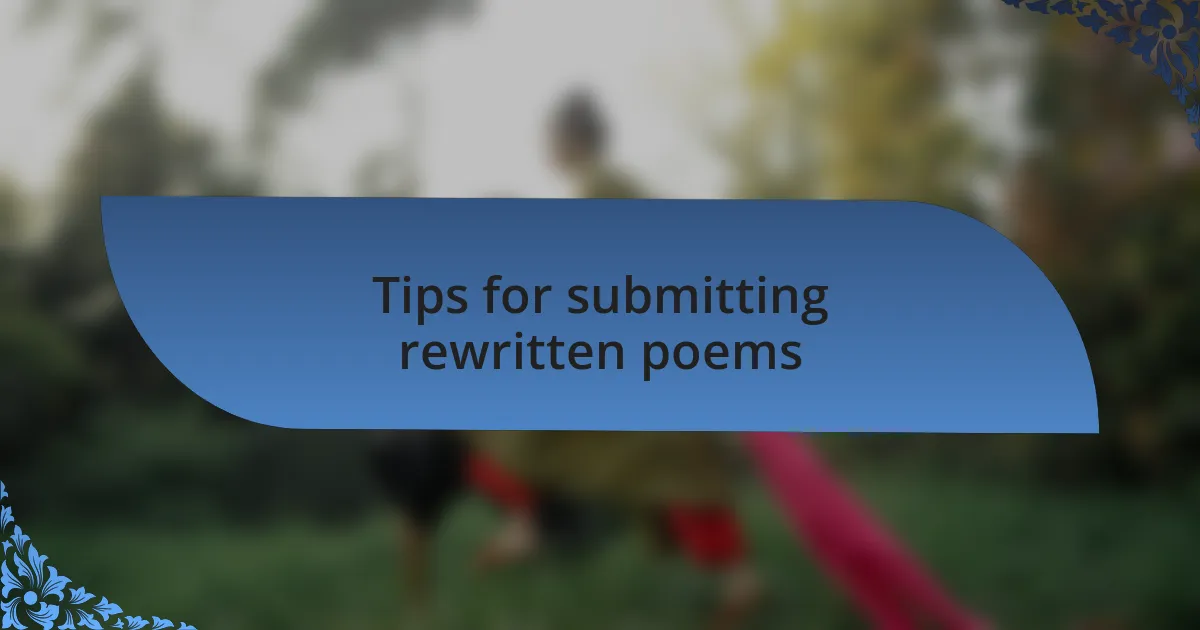
Tips for submitting rewritten poems
When it comes to submitting rewritten poems, always take the time to review submission guidelines carefully. I once missed an opportunity because I overlooked specific formatting requirements. It’s crucial to ensure your poem adheres to the journal’s style and word count; even the best work may get passed over for minor details.
Consider sharing your journey of rewriting in your cover letter. I’ve found that briefly outlining the evolution of a poem adds a personal touch that resonates with editors. It creates a dialogue that invites them into your creative process, making it more than just a submission—it’s a story they can connect with.
Before hitting that send button, allow time for a break from your poem. I’ve discovered that stepping away often brings clarity, allowing me to spot lingering imperfections. This little pause can be the difference between a good submission and a truly compelling one, helping ensure that my rewritten piece shines in its final form.